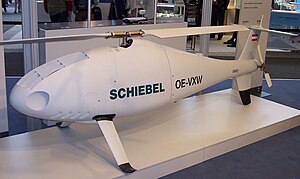This is one of the new drones I learned about this week from Austria. And all of these countries have one or more of this type of missile carrying helicopter drone already:
Schiebel Camcopter S-100
From Wikipedia, the free encyclopedia
| Camcopter S-100 | |
|---|---|
 |
|
| Camcopter S-100 | |
| Role | UAV |
| Manufacturer | Schiebel |
| Primary users | UAE Army German Navy Chinese Navy Russian Border Guard (Coast Guard) |
Contents
Design and development
Produced by the Austrian company Schiebel, it was developed from 2003 to 2005. With a maximum take-off weight (MTOW) of 200 kilograms (440 lb), its endurance is 6 hours. It has a maximum speed of 220 kilometres per hour (140 mph) and a ceiling of 5,500 metres (18,000 ft). It is powered by a 55 horsepower (41 kW) Diamond engine and can carry various payloads, such as electro-optics and infrared sensors.On 12 March 2012 Schiebel announced that it successfully tested a company-developed heavy-fuel engine interchangeable with the standard Diamond engine. This heavy-fuel engine allows for the use of JP-5, Jet A-1 or JP-8 jet fuels. These fuels, which are standard on marine vessels, are safer to store and handle than gasoline.[1]
On 7 February 2013, Schiebel flight tested a Thales Group I-Master surveillance radar system on the Camcopter at its Wiener Neustadt, Austria, facility. The I-Master system, weighing 30 kg (66 lb), provides ground moving target indication and synthetic aperture radar operations.[2]
International customers
Gorizont Air S-100, a Russian license-built version
The Camcopter underwent sea trials on the Indian Navy's INS Sujata (P56) during October 2007.[3] Flight testing occurred aboard a Pakistan Navy Type 21 frigate in the Arabian Sea on 16 March 2008,[4] with further naval testing on 14 April 2008 on the Spanish Guardia Civil vessel Rio Miño off Gran Canaria.[3][5]
The German Navy conducted testing during three weeks in August and September 2008 on the Braunschweig-class corvettes Braunschweig and Magdeburg, respectively. More than 130 takeoffs were conducted, and the UAV maintained unaided on-deck stability in greater than 15° flight deck roll conditions.[6][7]
The French Navy performed test flights during September and October 2008, with a Camcopter spending four days on a barge in the Atlantic Ocean and a further three days on the frigate Montcalm (D642).[3][8]
Libya ordered four Camcopters in 2009, which were placed under command of the Khamis Brigade.[9]
Jordan ordered two S-100s with L-3 Wescam MX-10 EO-IR payloads in July 2010 and accepted delivery in February 2011.[10]
In November 2011 the Camcopter demonstrated flights from the French Gowind-class corvette L'Adroit.[11] At the same time, the Gorizont (Horizon) Air S-100, a Russian license-built version of the UAV was successfully tested aboard the Coast Guard patrol cutter Rubin. Russia intends to equip all Rubin-class patrol boats with these UAVs.[12]
In 2010 the Chinese Navy purchased 18 of these systems. Two years later, in May 2012, an unmanned UAV believed to be a Camcopter S-100 was photographed operating from the fantail of a Chinese Type 054A frigate by the Japanese Maritime Self Defense Force.[13]
In April 2012, the Camcopter became the first unmanned helicopter to fly from an Italian Navy vessel when it was flight tested from the MM Bersagliere (F-584).[14] In February 2014, the Italian Navy chose the S-100 as its primary unmanned aerial system for shipboard operations, where it will be used for intelligence, surveillance and reconnaissance (ISR). It will additionally support other activities, such as search and rescue and natural disaster recovery.[15]
The Royal Australian Navy plans to test a Schiebel helicopter drone in June 2013.[16]
Airframe losses
On 28 May 2013, Somalia's Harakat al-Shabaab al-Mujahideen reportedly shot down a Camcopter S-100 operated by the U.S. military, and released photographs of the wreckage.[17]On 13 January 2015, a Camcopter S-100 was claimed shot down by Operation Dignity forces near el-Watya Airbase during the Second Libyan Civil War.[18]
Operators
States
Private
Specifications
S-100 fitted with a Lightweight Multirole Missile
Data from Schiebel.net (General);[19][20] Armada International (Powerplant 1);[21] Schiebel.net (Powerplant 2)[1]
General characteristics- Crew: None
- Capacity: 50 kg (110 lb)
- Length: 3.11 m (10 ft 2 in)
- Width: 1.24 m (4 ft 1 in)
- Height: 1.12 m (3 ft 8 in)
- Empty weight: 110 kg (243 lb)
- Max takeoff weight: 200 kg (441 lb)
- Fuel capacity: 57 L (15.5 gal) AVGas 100 LL
- Powerplant: 1 × Austro Engine AE50R Wankel engine, 41 kW (55 hp) (basic)
- Powerplant: 1 × Schiebel heavy fuel engine (optional)
- Main rotor diameter: 3.4 m (11 ft 2 in)
- Maximum speed: 222 km/h; 138 mph (120 kn)
- Cruise speed: 185 km/h; 115 mph (100 kn)
- Never exceed speed: 241 km/h; 150 mph (130 kn)
- Range: 180 km (112 mi; 97 nmi)
- Endurance: 6 hours
- Service ceiling: 5,486 m (18,000 ft)
- g limits: +3.5 g to -1 g
- Hardpoints: 2
See also
- Related lists
References
- "Compendium Drones 2011". Armada International (Internationale Armada AG) 35 (3): p. 26. June–July 2011. ISSN 0252-9793.
|chapter=ignored (help)
External links
| Wikimedia Commons has media related to Schiebel Camcopter S-100. |
- Schiebel website
- Camcopter S-100 at Defense-Update.com


No comments:
Post a Comment